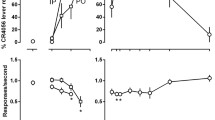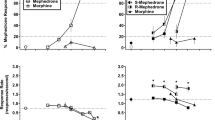Abstract
Risperidone was studied in a 0.16 mg/kg LSD-saline drug discrimination test procedure. At doses varying from 0.0025 to 0.63 mg/kg, no LSD-like agonist effects were observed. Studies on the antagonism of the LSD-cue indicated that risperidone was able to completely block the discriminative stimulus properties of LSD with a minimum ED50-value of 0.028 mg/kg. Risperidone was also very active over time with reference to LSD antagonism, the ED50s after 2, 4 and 8 h pretreatment being 0.028, 0.064 and 0.44 mg/kg. Response rate reductions were only observed at doses ≧0.16 mg/kg after 1 h and at 0.63 mg/kg after 2 h pretreatment. Four and 8 h after treatment, no rate-reducing effects were apparent at doses up to 2.50 mg/kg. Thus at pretreatment intervals ranging between 2 and 8 h, complete antagonism of LSD without any rate effects was obtained. As compared to other LSD antagonists, risperidone was quantitatively better than setoperone and ritanserin and longer acting than pirenperone. Based on the pharmacological profile of risperidone and the other LSD antagonists, it was concluded that a potent central 5-HT2 and catecholamine antagonism is needed for a potent and complete antagonism of the 0.16 mg/kg LSD-cue. The potential clinical effect of risperidone in the positive and negative symptoms of schizophrenia is discussed.
Similar content being viewed by others
References
Abramson HA, Jarvik ME, Kaufman MR, Kornetsky C, Levine A, Wagner M (1955) Lysergic acid diethylamide (LSD-25): I. physiological and perceptual responses. J Psychol 39:3–10
Ansseau M, Doumont A, Thiry D, Gelders Y (1983) Pilot study of a specific serotonergic antagonist, pirenperone, in the treatment of anxiety disorders. Acta Psychiatr Belg 83: 517–524
Appel JB, White FJ, Holohean AM (1982) Analyzing mechanism(s) of hallucinogenic drug action with drug discrimination procedures. Neurosci Biobehav Rev 6:529–536
Awouters F, Niemegeers CJE, Megens AAHP, Meert TF, Janssen PAJ (1988) The pharmacological profile of ritanserin, a very specific central serotonin-S2 antagonist. Drug Dev Res (in press)
Bressa GM, Marini S, Gregori S (1987) Serotonin-S2 receptor blockade and generalized anxiety disorders. A double-blind study on ritanserin and lorazepam. Int J Clin Pharmacol Rev 7:111–119
Ceulemans DLS, Gelders YG, Hoppenbrouwers M-LJA, Reyntjens AJM, Janssen PAJ (1985) Effect of serotonin antagonism in schizophrenia: a pilot study with setoperone. Psychopharmacology 85:329–332
Charney DS, Heniger GR, Redmond DE (1983) Yohimbine induced anxiety and decreased noradrenergic function in humans: effects of diazepam and clonidine. Life Sci 33:19–29
Cohen S (1967) Psychotomimetic agents. Annu Rev Pharmacol 7:301–318
Colpaert FC (1984a) Drug discrimination: behavioral pharmacological, and molecular mechanisms of discriminative drug effects. In: Goldberg SR, Stolerman IP (eds) Behavioral analysis of drug dependence. Academic Press, New York, pp 161–193
Colpaert FC (1984b) Cross generalization with LSD and yohimbine in the rat. Eur J Pharmacol 102:541–544
Colpaert FC, Janssen PAJ (1983) A characterization of LSD-antagonist effects of pirenperone in the rat. Neuropharmacology 22:1001–1005
Colpaert FC, Janssen PAJ (1984) A possible α2-adrenergic component in the in vivo activity of pirenperone. Eur J Pharmacol 103:169–171
Colpaert FC, Leysen JE (1981) Characterization of in vivo agonist and antagonist activity of purported 5-hydroxytryptamine antagonists and of R 47465, and LSD-antagonist. Paper presented at the 8th International Congress of Pharmacology, Abstract No. 1224
Colpaert FC, Niemegeers CJE, Janssen PAJ (1979) In vivo evidence of partial agonist activity exerted by purported 5-hydroxytryptamine antagonists. Eur J Pharmacol 58:505–509
Colpaert FC, Niemegeers CJE, Janssen PAJ (1982) A drug discrimination analysis of lysergic acid diethylamide (LSD): in vivo agonist and antagonist effects of purported 5-hydroxytryptamine antagonists and of pirenperone, a LSD-antagonist. J Pharmacol Exp Ther 221:206–214
Colpaert FC, Meert FT, Janssen PAJ (1984) Disinhibitory effect of LSD antagonists on rat behavior. In: Proceedings of Collegium Internationale Neuro-Psychopharmacologicum, 14th C.I.N.P. Congress, June 19–23, Florence, Italy, p 311
Colpaert FC, Meert TF, Niemegeers CJE, Janssen PAJ (1985) Behavioral and 5-HT antagonist effects of ritanserin: pure and selective antagonist of LSD discrimination in rat. Psychopharmacology 86:45–54
Cunningham KA, Appel JB (1987) Neuropharmacological reassessment of the discriminative stimulus properties of d-lysergic acid diethylamide (LSD). Psychopharmacology 91:67–73
Finney DJ (1971) Statistical methods in biological assay, 2nd edn. Griffin Press, London
Freedman DX (1968) On the use and abuse of LSD. Arch Gen Psychiatry 18:330–347
Freedman DX (1969) The psychopharmacology of hallucinogenic agents. Annu Rev Med 20:408–418
Geyer MA, Braff DL (1982) Habituation of the blink reflex in normals and schizophrenic patients. Psychophysiology, 19:1–6
Geyer MA, Braff DL (1987) Startle habituation and sensorimotor gating in schizophrenia and related animal models. Schizophr Bull 13:643–668
Geyer MA, Petersen LR, Rose GJ, Horwitt DD, Light RK, Adams LM, Zook JA, Hawkins RL, Mandell AJ (1978). The effects of LSD and mescaline-derived hallucinogens on sensory-integrative function: tactile startle. J Pharmacol Exp Ther 207:837–847
Glennon RA, Titeler M, McKenney JD (1984) Evidence of 5-HT2 involvement in the mechanism of action of hallucinogic agents. Life Sci 35:2505–2511
Hirschhorn ID, Winter CJ (1971) Mescaline and lysergic acid diethylamide (LSD) as discriminative stimuli. Psychopharmacology 22:64–71
Holmberg G, Gershon S (1961) Autonomic and psychic effects of yohimbine hydrochloride. Psychopharmacology 2:93–106
Hoppenbrouwers M-L, Gelders Y, Vanden Bussche G (1986) Ritanserin (R 55667) an original thymostenic. Boll Chim Farm 125:1369–1379
Isbell H (1959) Comparison of the reactions induced by psilocybin and LSD-25 in man. Psychopharmacology 1:29–38
Janssen PAJ (1987) The development of new antipsychotic drugs — towards a new strategy in the management of chronic psychoses. In: Biological psychiatry in Europe today, De Medicus bv. Leiderdorp, The Netherlands, pp 15–19
Janssen PAJ, Niemegeers CJE, Awouters F, Schellekens KAH, Megens AAHP, Meert TF (1988) Risperidone (R 64766), a new and highly effective antipsychotic with a novel mode of action. J Pharmacol Exp Ther 244:685–693
Kuhn DM, White FJ, Appel JB (1977) Discriminative stimulus properties of hallucinogens: Behavior assay of drug action. In: Lal H (ed) Discriminative stimulus properties of drugs. Plenum Press, New York, pp 137–154
Kuhn DM, White FJ, Appel JB (1978) The discriminative stimulus properties of LSD; mechanisms of action. Neuropharmacology 17:257–263
Leysen JE (1987) The use of 5-HT receptor agonists and antagonists for the characterization of their respective receptor sites. In: Boulton AA, Baker GB, Juorio AU (eds) Neuromethods, neuropharmacology II: Drugs as tools in neurotransmitter research. Humana Press (in press)
Leysen JE, Niemegeers CJE, Van Nueten JM, Laduron PM (1982) [3H]Ketanserin (R 41468), a selective 3H-ligand for serotonin2 receptor binding sites. Mol Pharmacol 21:301–304
Leysen JE, Gommeren W, Van Gompel P, Wynants J, Janssen PFM, Laduron PM (1985) Receptor-binding properties in vitro and in vivo of ritanserin. A very potent and long acting serotonin-S2 antagonist. Mol Pharmacol 27:600–611
Meert TF (1986) A comparative study of the effects of ritanserin (R 55667) and chlordiazepoxide on rat open field behavior. Drug Dev Res 8:197–204
Meert TF, Colpaert FC (1986) Effects of S2-antagonists in two conflict procedures that involve exploratory behavior. Psychopharmacology 89:S23
Meert TF, Niemegeers CJE, Gelders Y, Megens AAHP, Awouters F, Janssen PAJ (1987a) Risperidone (R 64 766) a new antipsychotic agent with a novel mode of action. In: Proceedings of Behavioural Pharmacology of 5-HT Congress, Amsterdam (The Netherlands), November 24–27, p 64
Meert TF, Niemegeers CJE, Gelders Y, Janssen PAJ (1987b) Ritanserin (R 55667) an original thymosthenic. In: Proceedings of Behavioural Pharmacology of 5-HT Congress, Amsterdam (The Netherlands), November 24–27, p 66
Meert TF, Niemegeers CJE, Awouters F, Janssen PAJ (1988) Partial and complete blockade of 5-HTP-induced head twitches in the rat. A study of ritanserin (R 55667), risperidone (R 64 766) and related compounds. Drug Dev Res (in press)
Meltzer HY, Simonovic M, Gudelsky GA (1983) Effects of pirenperone and ketanserin on prolactin secretion in vivo and in vitro. Eur J Pharmacol 92:83–89
Reyntjens A, Gelders YG, Hoppenbrouwers M-LJA, Vanden Bussche G (1986) Thymostenic effects of ritanseria (R 556667), a centrally acting serotonin-S2 receptor blocker. Drug Dev Res 8:205–211
Rosecrans JA, Glennon RA (1979) Drug-induced cues in studying mechanisms of drug action. Neuropharmacology 18:981–989
Salvatore S, Hyde RW (1956) Progression of effects of lysergic acid diethylamide (LSD). Arch Neurol Psychiatry 76:50–59
Siegel S (1956) Nonparametric statistics for the behavioral sciences. McGraw Hill Book Co, New York
Titeler M, Lyon RA, Glennon RA (1988) Radioligand binding evidence implicantes the brain 5-HT2 receptor as a site of action for LSD and phenylisopropylamine hallucinogens. Psychopharmacology 94:213–216
Winter JC (1975) The effects of 2,5-dimethoxy-4-methylamphetamine (DOM), 2,5-dimethoxy-4-ethylamphetamine (DOET), d-amphetamine, and cocaine in rats trained with mescaline as a discriminative stimulus. Psychopharmacology 44:29–32
Winter JC (1978) Stimulus properties of phenethylamine hallucinogens and lysergic acid diethylamide: the role of 5-hydroxytryptamine. J Pharmacol Exp Ther 204:416–423
Winter JC (1980) Effects of phenethylamine derivates. BL-3912, fenfluramine, and Sch-12679, in rats trained with LSD as a discriminative stimulus. Psychopharmacology 68:159–162
Author information
Authors and Affiliations
Rights and permissions
About this article
Cite this article
Meert, T.F., de Haes, P. & Janssen, P.A.J. Risperidone (R 64 766), a potent and complete LSD antagonist in drug discrimination by rats. Psychopharmacology 97, 206–212 (1989). https://doi.org/10.1007/BF00442251
Received:
Accepted:
Issue Date:
DOI: https://doi.org/10.1007/BF00442251




